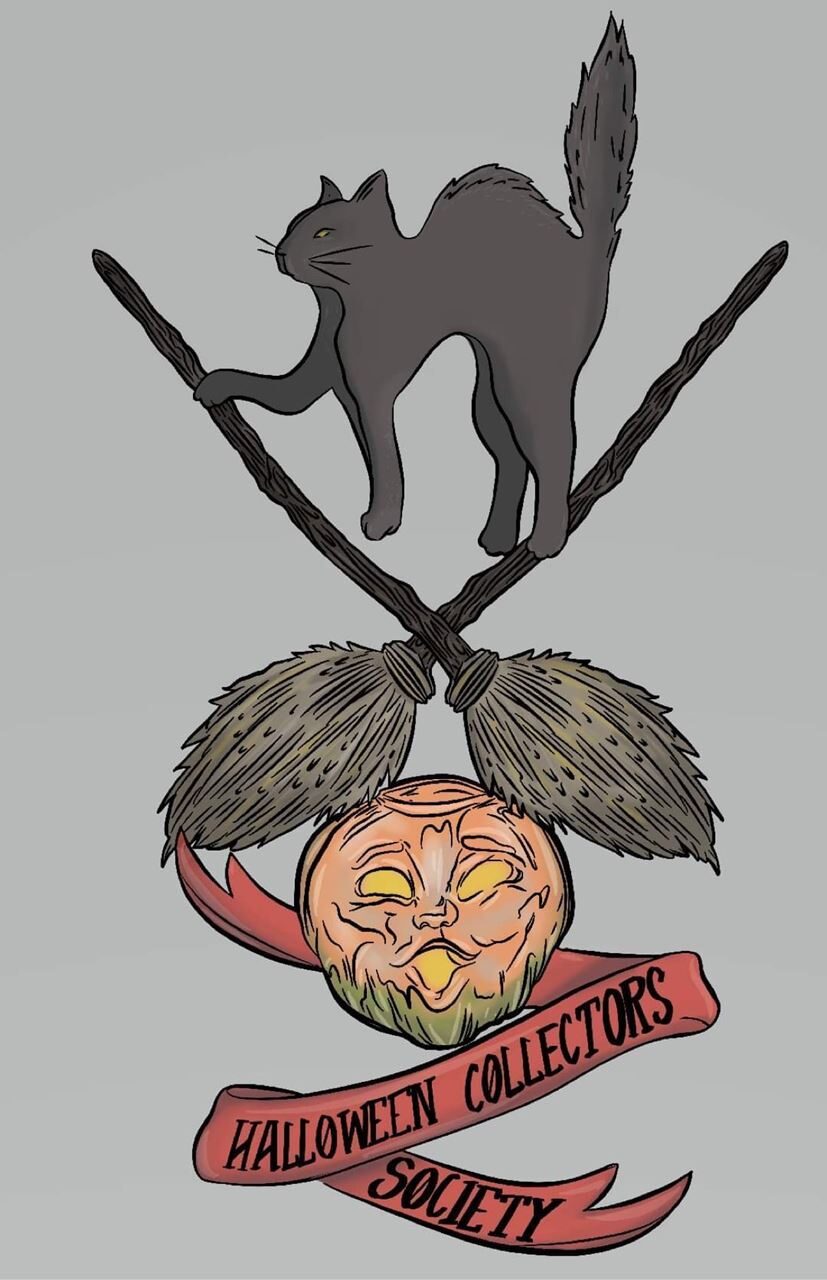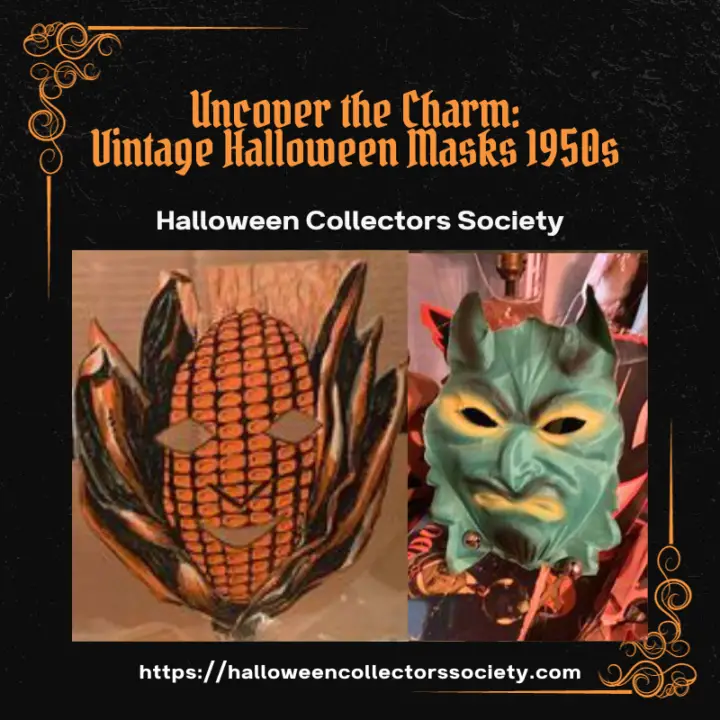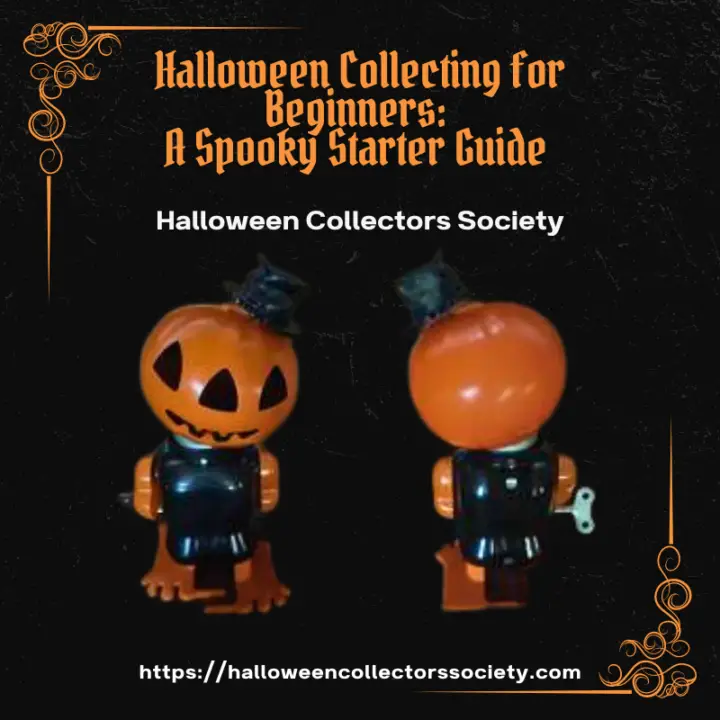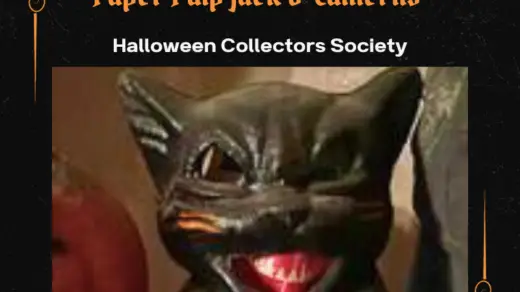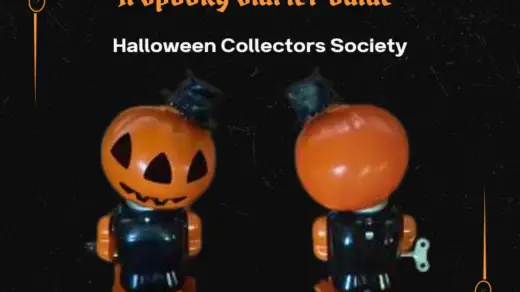Step back in time with me as we delve into the enchanting world of vintage Halloween masks from the 1950s.
This was an era filled with the magic of television and the ever-present allure of popular culture.
But what truly makes this period special is how it brought classic horror characters to life in a tangible way, all thanks to the introduction of specially designed Halloween masks.
These masks, crafted from innovative materials like celluloid, latex, and plastic, have now become timeless relics of a bygone era.
In this journey, we’re going to explore their historical origins, their lasting influence on modern Halloween aesthetics, and the art of collecting and preserving these cherished vintage treasures.
It’s a trip down memory lane that’s sure to deepen your appreciation for these charming pieces of yesteryear.
So, get ready for a captivating adventure into the captivating world of 1950s Halloween masks, where nostalgia and spookiness go hand in hand.
Historical Background of Halloween Masks 1950s
Upon peering into the fascinating realm of vintage Halloween masks, one is transported into a unique era that cleverly blurs the line between creepy and charming.
The 1950s was remarkable, seeping with significance in this niche.
Back then, Halloween was more than just an evening of fright – it was a cultural phenomenon that mirrored the socio-economic climate and trends of the times.
Primarily made from plastic injection molding, vintage Halloween masks from the 1950s are not only pieces of history but also are reflective of the technological progress of those times.
The technological boom post World War II allowed for easier, quicker, and cheaper mass production of masks.
The target audience expanded from adults in festive parades to children trick-or-treating around their neighborhoods.
At a time when watching television became a regular pastime in American households, these masks often enhance a newfound fascination with pop-culture characters.
Today, unearthing a Casper the Friendly Ghost or a Howdy Doody mask from the era is like finding a treasure trove of childhood nostalgia.
The designs of these vintage masks were a study in artistry and ingenuity.
From the iconic anonymous ghoul to fanciful monsters, these fantastic faces hardly crossed the line into truly menacing territory.
Instead, these vintage masks were representative of a gentler, more playful vision of the holiday – a spooky yet whimsical homage to the spirits walking among us.
Believe it or not, these phantom faces from a bygone era contributed significantly to a broader cultural dialogue as well.
The post-war socio-economic boom, an overall feel of abundance and prosperity, likely contributed to Halloween’s transformation into a more joyful, less haunting holiday.
The 1950s saw the beginning of trick-or-treating – a community-building event that encouraged neighborly interaction and showcased youngsters in colorful themed masks.
These vintage masks also made chillingly accurate political statements.
The appearance of masks of political figures underscored the larger backdrop of the Cold War climate.
From the benign to the bemusing, these remarkable representations narrated vital elements of contemporary history that were equally insightful and inversely entertaining.
Renowned artists such as Ben Cooper and HP Halvorsen left indelible footprints in the world of vintage Halloween masks.
Their creative prowess and dedication have left us with an array of collectible masks that are reflective of an era – masks that echo values, dreams, fears, societies, and much more of the 1950s.
So while the creaky additions to any vintage Halloween mask collection may feel eerily lifeless, they are veritably pulsing with historical narratives from a past era.
Every eye hole sighted Cold War era dread.
Every toothy grin mirrored technological prowess.
Every pop-culture inspired face played a significant role in shaping modern Halloween.
And just like that, the silent faces of holiday ghouls from the past whisper tales of cultural gravitas, making these vintage Halloween masks a fascinating, phantom-like portal to the past.
Vintage Halloween Masks: Delving into the Intricacies of Materials and Manufacturing Techniques
If there’s one thing to be admired about vintage Halloween masks, it’s the undeniable craftsmanship involved in their creation.
As we journey into the distinctive materials and manufacturing techniques used to shape these whimsical wonders, prepare to be immersed in a world of great ingenuity and creativity.
The primary material used in the making of vintage Halloween masks was none other than good old-fashioned latex rubber.
Originating from the sap of the rubber tree (Hevea brasiliensis), latex offered the perfect blend of flexibility, durability, and eeriness due the skin-like feeling it offered upon touch.
However, to translate this material into a visible nightmare – or delight, manufacturers resorted to some intriguing techniques.
The process commenced with a ‘sculpt’, or master mold, usually crafted using industrial clay or plaster.
Skilled artists meticulously worked on these sculptures, creating features down to the minutest detail.
Remember that creepy little wrinkle on your favorite witch mask from yesteryears?
All thanks to these master sculptors!
Post sculpting, the sculpture was coated with liquid latex multiple times until a sufficiently thick layer was acquired.
Each layer was let to dry before another layer was added on.
This process was called ‘slush molding’ or ‘dip molding.’
Once the desired thickness was reached, the inner latex shell was delicately removed from the sculpt, leading to the birth of a raw, undecorated mask.
Now, onto the enthralling world of mask artistry!
The real magic sprinkled by the artists was in the painting process.
Relying on oil-based paints, the artists hand-painted each mask, assuring every detail was vibrant and distinct.
Particular emphasis was placed on the mask’s eyes, as they were the pivotal elements steering the mask’s overall persona.
Using gradient and shading techniques, the artists ensured the hollow mask eyes seemingly sprung to life.
That’s right, those ghastly ghouls or playful pumpkins weren’t mass production escapades, but rather, pieces of detailed handiwork!
Sometimes, for added texture, patches of synthetic fur were glued to the masks.
Think werewolf or King Kong masks which boasted patches of hair, contributing to their overall terrifying aura.
Other additions included colorful synthetic feathers for bird-themed masks or flexible plastic horns for devil masks.
In retrospect, creating vintage Halloween masks was an intricate affair, demanding both technical expertise and a flair for the arts.
The evolved manufacturing techniques, coupled with the tireless artistry, played crucial roles in forming the incredible, often haunting visages, forever imprinted in our cultural milieu.
Their timeless appeal continues to bridge the gap between the past and present, proving that true creativity never confines itself within the bounds of time.
Collecting and Preserving Vintage Halloween Masks
Continuing further in this entrancing world of vintage Halloween masks from the 1950s, one must address critical aspects in regards to their collection and preservation.
The masks from this era are often pieces of history sewn together by artists’ fingers that plied fine details into their work and engaged a generation of lighter, joyous Halloween celebrations.
This fascinating journey travels through the mechanics of mask making, and the artistic undertones that not only shaped their intricate design but also a path towards their long-term preservation.
Vintage Halloween masks are mostly constructed from latex rubber.
This was the material of choice during the 1950s as it ensured flexibility and durability, embracing features such as elasticity, which was paramount for the masks to fit a broad range of sizes, from adults to children.
Further, latex was relatively inexpensive and feasible to work with for creators, making it an integral component of authentic vintage Halloween masks.
One cannot discuss these masks without understanding the process behind creating a mask’s mold or sculpt.
Crafted with precision, the mask’s initial design was sketched on a clay model replicating a human face.
This was the first step to manifest a physical form from an idea, a beautifully complex process that speaks volumes about the craftsmanship of the era.
Masks of this era utilized the slush molding or dip molding technique.
The carved clay model got dipped into a pool of liquid latex. Once dried, a thin layer of latex clung to the mold, seamlessly capturing the intricacies of the design.
This layer defined the mask’s shape and created a resilient structure that would withstand time and wear, an attribute necessary for any vintage Halloween mask collector to consider.
The elements of creativity didn’t just stop at designing the mold and its sculpt.
Artists painstakingly worked to remove the dried inner latex shell from the clay model.
The delicate process managed to bring out the details of the prototype off the clay, ensuring the mask maintained the original design, a testament to the meticulous artistry that went into creating these vintage pieces.
Evolving from simply molding, the artistry extended to painting the masks.
The diverse palette captured the Halloween spirit, from ghastly whites and ethereal blues to fiery reds and stark blacks.
Emphasis was laid on the eyes as they became the portals through which the mask’s character peered into the world.
Shading techniques granted an added depth to these featureless latex models, following the ethos of the 1950s – a blend of the thrill and joy.
With vintage mask manufacturing, adding texture played a crucial role.
Synthetic fur, feathers, and plastic horns were affixed to the latex shell, accentuating the details and enabling the creation of a wide variety of imaginative and eerie designs.
The masks of witches, devils, cats, and creatures from the human imagination sprung to life from the hands of these creators, giving 1950s Halloween masks their iconic status.
Vintage Halloween mask manufacturing was not just about a physical process but was a powerful act of artistic expression.
The authenticity of details, usage of latex rubber, and the painstaking creation process all contribute to the charm of these vintage treasures.
Above the thrill of unmasking the creative process behind these pieces, lies the real charm – preserving that nostalgia and carrying forward the joy of Halloween from the past into the future.
Collecting and preserving these masks is maintaining a link to our past, a past filled with creative expression and light-hearted spooky fun.
Through this journey, we don’t just collect masks – we collect stories, lives, and times that once were, and continue to influence who we are today.
The lure of these vintage Halloween masks continues to captivate, enchanting and entrancing with their timeless appeal.
Influence on Modern Halloween Masks
Now that we have outlined some of the era-specific influences and production steps, let’s delve into how these vintage masks have shaped the creative designs that we view today.
Where 1950’s Halloween masks were marked by bold color palettes, vibrant characters, and widely loved pop culture representations, modern masks have expanded on these ideas, incorporating intricate crafting techniques and using them as the foundation for diverse themes.
Tellingly, many elements from the 1950s masks still echo in the designs found today.
While modern mask makers use a variety of materials and techniques due to advancements in technology, many have stayed true to the 1950s practice and still use latex since it is easy to mold, durable, and boasts a realistic skin-like appearance.
But modern mask makers learned from the 1950s creators and incorporated more safety precautions, ensuring better comfort without sacrificing that classic Halloween aesthetic.
The design process inspired by vintage models keeps alive the tradition of mold creation, with many contemporary mask makers still using clay to form mask prototypes.
The dip molding technique utilized back then has also found its relevance in modern creations, providing the perfect base to construct detailed and complex designs.
Likewise, 1950s masks mastered the artistry of embracing pop culture.
No Halloween celebration is now complete without contemporary adaptations of popular movie characters, cartoons, or public figures.
It’s an homage to those vintage masks, preserving tradition while aligning with changing tastes.
Adding texture to masks was a trick first utilized in the 50s.
This is now a regular feature in modern designs. Synthetic fur, plastic horns, feathers, and other materials allow designers to add a unique flair, introduce startling realism, and broaden their creative horizons.
This adds tangibility and depth that not only enhances the visual impact but the overall user experience as well.
Color palette choices have also somewhat retained their vintage influence.
While modern designs can be more nuanced and explore a broader range of hues, the love for bright, saturated colors — a characteristic trait of 1950s masks — is still much in vogue.
Especially the focus on eyes, a key element present since the vintage days, helps to intensify expressions and bring life to today’s Halloween masks.
The value and influence of vintage 1950s Halloween masks on contemporary designs are significant.
As modern Halloween gets edgier and embraces technology, the roots in the vintage past provide an anchoring core.
This ensures that each mask is a piece of art, a story, and a vibrant cheer to our shared love for Halloween celebration and its changing, yet timeless traditions.
Appreciating this marriage of the old and the new, it is exciting to imagine how future Halloween masks will continue to evolve, all the while carrying a piece of the 1950s with them, embracing their historical context and respecting the pioneering creativity of the golden era.
Unmasking the Timeless Appeal of 1950s Halloween Treasures
Whether you’re a dedicated collector, a passionate vintage enthusiast, or someone who simply appreciates the allure of the unique, the world of Halloween masks 1950s holds an enchanting and irresistible charm.
These artifacts, born in an era that continues to captivate our imaginations, play an essential role in our modern Halloween celebrations, underlining their enduring significance.
Beyond the spine-tingling fun and excitement they bring to our All Hallows’ Eve traditions, vintage masks open a fascinating window into a bygone era, reflecting the cultural and technological transformations of their times.
They embody a cherished part of our history, and these captivating relics maintain their influence on our present, remaining a significant piece of our shared Halloween heritage.
In cherishing these masks, we not only keep the spirit of Halloween alive but also ensure that their legacy endures for future generations to explore and enjoy.
These vintage treasures are more than just masks; they are a portal to the past, connecting us with the Halloween traditions of yesteryears, and their magic continues to cast a spell on us today.
Masked Marvels
This is where we focus specifically on vintage Halloween masks, their history, designs, and collector’s tips.
Uncover the Charm: Vintage Halloween Masks 1950s
Explore the enchanting world of vintage Halloween masks 1950s. Discover their timeless appeal and influence on modern designs.
Halloween Collecting for Beginners: A Spooky Starter Guide
Discover the enchanting world of Halloween collecting for beginners - tips, community, and spooky treasures await!
Unlock the Mysteries of Halloween Collectibles: Ask The Experts
Unlock the Mysteries of Halloween Collectibles! Ask the Experts for insights into the world of spooky treasures.

